Middle Eastern Desserts: Timeless Flavors That Warm the Heart
Middle Eastern desserts are a true celebration of tradition, flavor, and texture. Whether you’re craving flaky baklava or date-filled maamoul, these treats bring a sense of comfort and festivity to the table. In this article, we’ll dive into the vibrant world of Middle Eastern desserts—exploring their cultural roots, essential ingredients, iconic sweets, and how you can recreate them in your own kitchen. Along the way, you’ll discover tips, FAQs, and easy connections to familiar recipes like carrot cake bars and Easter desserts. Let’s uncover the sweet secrets of the Middle East together.
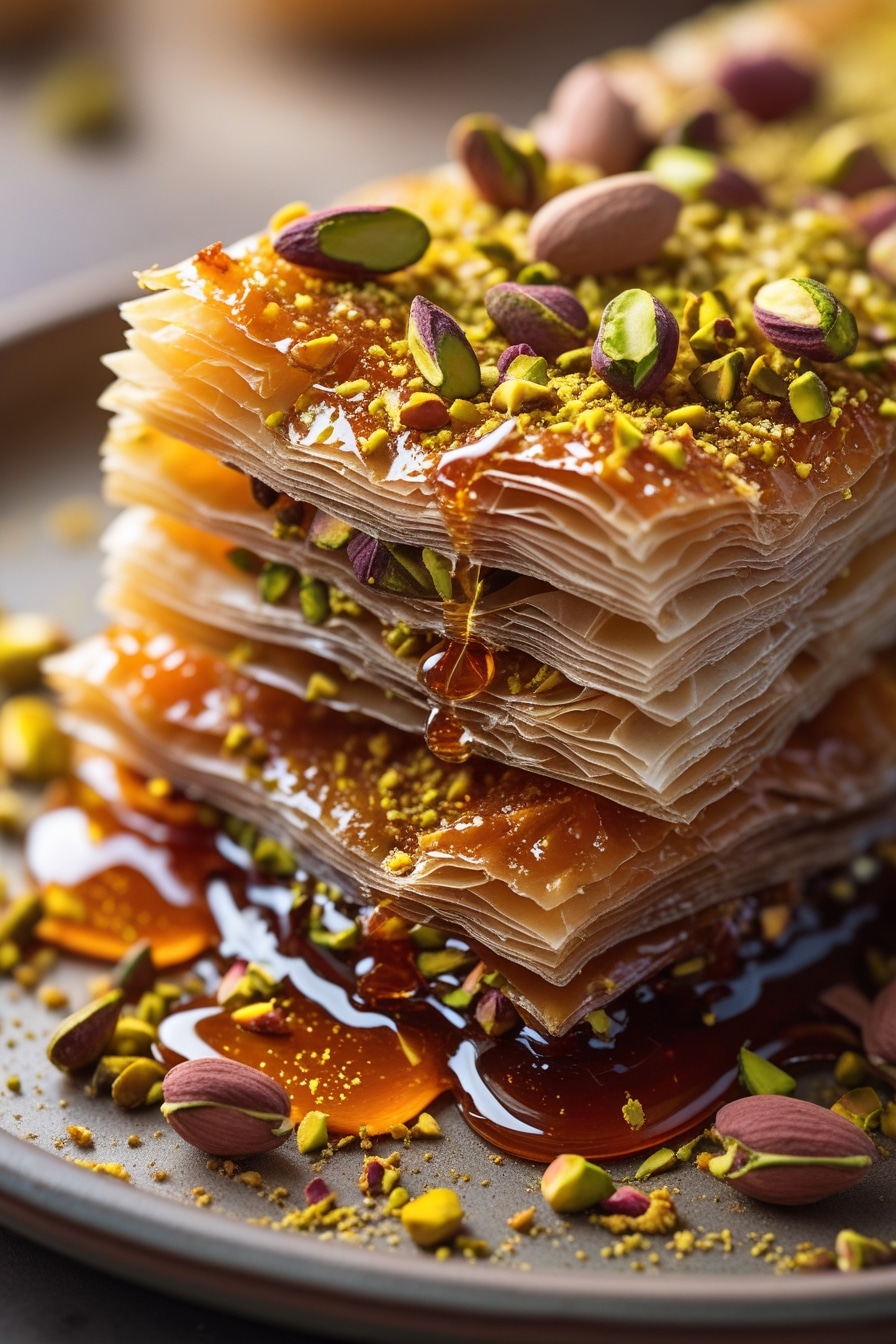
Middle Eastern Desserts
Ingredients
- 1½ cups semolina fine or medium
- 1 cup phyllo dough sheets thawed
- ½ cup unsalted butter or ghee melted
- 1 cup granulated sugar
- ¾ cup plain Greek yogurt
- ½ cup chopped pistachios
- ½ cup chopped walnuts
- 1 cup pitted dates or ready-made date paste
- 2 tablespoons rose water
- 1 tablespoon orange blossom water
- 2 tablespoons lemon juice
- 1½ cups whole milk
- 2 tablespoons cornstarch
- 1 cup all-purpose flour
- 1 teaspoon baking powder
- Optional: shredded coconut cinnamon, powdered sugar (for garnish)
Instructions
- Prepare the syrup: In a saucepan, simmer 1 cup sugar with ½ cup water, lemon juice, and rose water until slightly thickened. Let it cool completely before use.
- Bake the basbousa: Mix semolina, yogurt, sugar, and melted butter. Pour into a greased baking dish, top with almonds or coconut if desired, and bake at 350°F for 30–35 minutes. Pour cooled syrup over hot cake and let it absorb.
- Make the baklava: Layer phyllo dough sheets in a buttered baking dish, brushing each sheet with melted butter. Add chopped nuts between layers. Bake at 350°F until golden, then immediately pour cooled syrup over the hot baklava.
- Shape the maamoul: Mix flour, semolina, butter, and a splash of rose water into a dough. Fill with date paste or chopped nuts. Shape using maamoul molds or by hand. Bake at 350°F for 15–20 minutes until lightly golden.
- Cook the muhallabia: In a saucepan, whisk milk, cornstarch, and sugar over medium heat until thickened. Remove from heat, stir in rose and orange blossom water, then pour into serving cups. Chill and top with pistachios.
Nutrition
table of content
Table of Contents
The Story & Intro: Why Middle Eastern Desserts Steal the Show
The Warmth of My Grandmother’s Kitchen
Hi, I’m Elina—home cook, recipe developer, and mom behind Easy Meals Table. My love for cooking began in my grandmother’s kitchen, where cinnamon always lingered in the air, and there was never a shortage of semolina, dates, or rose water. One of my fondest memories was helping her shape maamoul cookies during Eid. The smell of buttery dough filled with sticky date paste is something I’ll never forget. It wasn’t just dessert; it was celebration, love, and legacy rolled into one. That’s what makes Middle Eastern desserts so powerful—they connect you to people, culture, and generations past.
Just like the joy I feel baking simple treats like carrot cake mix bars, Middle Eastern desserts remind me that food doesn’t have to be complicated to be meaningful. You just need the right ingredients and the desire to share something sweet.
Middle Eastern Dessert Ingredients & Origins
Essential Ingredients That Define Middle Eastern Desserts
Middle Eastern desserts share a unique pantry of ingredients that give them their iconic flavors. Staples include:
Semolina – Used in classics like basbousa, semolina adds texture and subtle flavor.
Pistachios & Walnuts – These nuts add crunch and richness to sweets like baklava and nammoura.
Dates – A natural sweetener, dates are the star in treats like maamoul and sticky date pudding.
Middle Eastern desserts are often elevated by the delicate floral notes of rose water and orange blossom, giving them a uniquely aromatic charm.
Honey & Simple Syrup – Unlike Western desserts heavy on frostings, Middle Eastern sweets often rely on sweet syrups to enhance texture and flavor.
Pair these with ingredients you may already have in your pantry—like sugar, butter, and flour—and you’re halfway to your own baklava tray.
Cultural Origins and Celebratory Roots
Middle Eastern desserts aren’t just about indulgence—they’re a part of culture and celebration. These recipes often trace back through generations, deeply rooted in family customs and religious celebrations:
Eid and Ramadan bring out stuffed date cookies (maamoul), qatayef (stuffed pancakes), and kunafa.
Christian holidays in Lebanon and Palestine often feature sfouf and rose-scented puddings.
At weddings and festive gatherings, it’s common to serve baklava layered with nuts and drenched in sweet syrup.
Just like our Western holiday desserts, Middle Eastern sweets are tied to emotion, memory, and meaning. And they’re designed to be shared—on trays, in tins, or over coffee with family and friends.
Comparing Global Dessert Styles
Unlike the dairy-forward or chocolate-heavy desserts from Europe and the U.S., Middle Eastern desserts tend to favor:
Syrup over frosting
Nut and grain textures over spongey layers
Lightly spiced and floral instead of overly sugary
They’re often less sweet but more aromatic. Think of the contrast between American oreo ice cream cake and a piece of crisp, rose-scented baklava—both rich, yet very different in tone and texture.
Quick Tips for Beginners
Want to start with something easy? Try these beginner-friendly options:
| Dessert | Texture | Key Ingredients | Tip for Beginners |
|---|---|---|---|
| Basbousa | Soft & grainy | Semolina, yogurt, syrup | Use Greek yogurt for better body |
| Maamoul | Crumbly | Dates, semolina, ghee | Chill the dough before shaping |
| Rice Pudding | Creamy | Rice, milk, rose water | Stir continuously for smooth texture |
| Kunafa | Crunchy | Kataifi dough, cheese/syrup | Pre-toast the kataifi for crispness |
For something more familiar, you can incorporate Middle Eastern flavors into everyday recipes. Imagine using cardamom in overnight oats or drizzling rose syrup over carrot cake bars—fusion at its finest!
Classic Middle Eastern Desserts You Need to Try
Baklava: The Queen of Middle Eastern Sweets
When most people think of Middle Eastern desserts, baklava immediately comes to mind—and for good reason. This golden, flaky pastry is made with dozens of layers of phyllo dough, chopped nuts (often pistachios or walnuts), and drenched in a spiced syrup flavored with lemon juice, cinnamon, and either rose water or orange blossom.
Each bite is crisp, nutty, and just the right amount of sweet. Some versions include a hint of cardamom or cloves, adding warmth and depth. Baklava is traditionally served in small diamond or triangle-shaped pieces, making it ideal for sharing at weddings, holidays, or family gatherings.
If you’re familiar with indulgent treats like Oreo ice cream cake, you’ll find baklava similarly satisfying but with a nutty crunch that’s uniquely Middle Eastern.
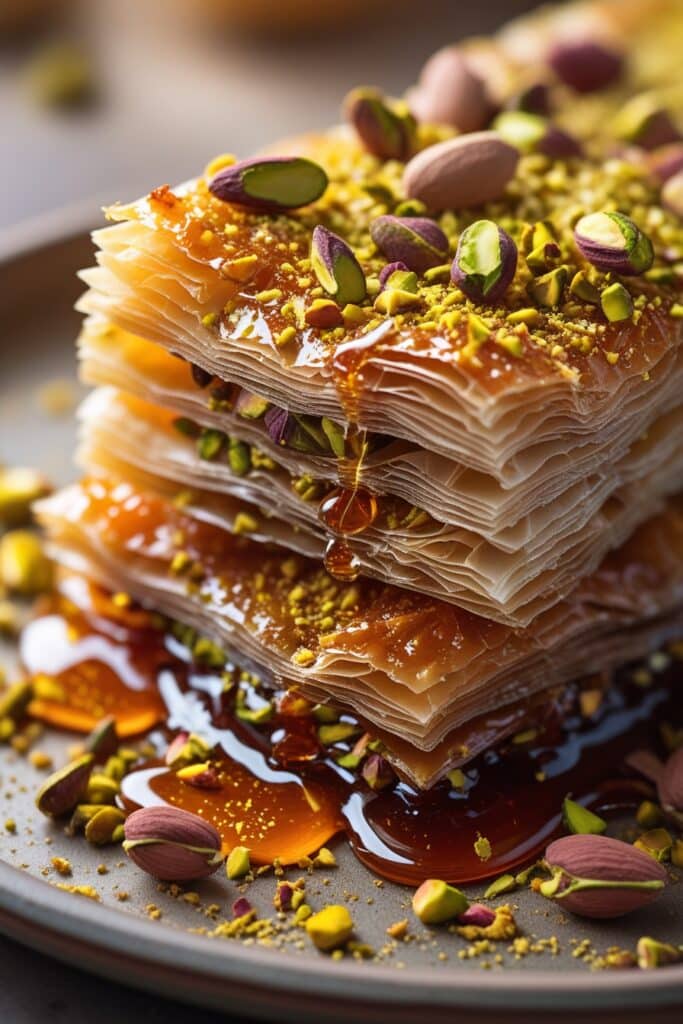
Basbousa: Sweet, Simple, and Satisfying
Also known as harissa or revani in different regions, basbousa is a semolina cake soaked in syrup after baking. It’s soft, dense, and slightly grainy thanks to the coarse semolina, but the syrup transforms it into a moist, melt-in-your-mouth treat. Often topped with almonds or shredded coconut, basbousa is one of the easiest Middle Eastern desserts to make at home.
Basbousa is especially loved during Ramadan and other religious festivals due to its simplicity and richness. One pan can easily serve a family, and leftovers taste even better the next day.
To make your own, you just need a few pantry staples—semolina, sugar, yogurt, and butter—then add your favorite twist with orange zest or coconut. It’s a perfect weekend bake, just like our cozy carrot cake mix bars.
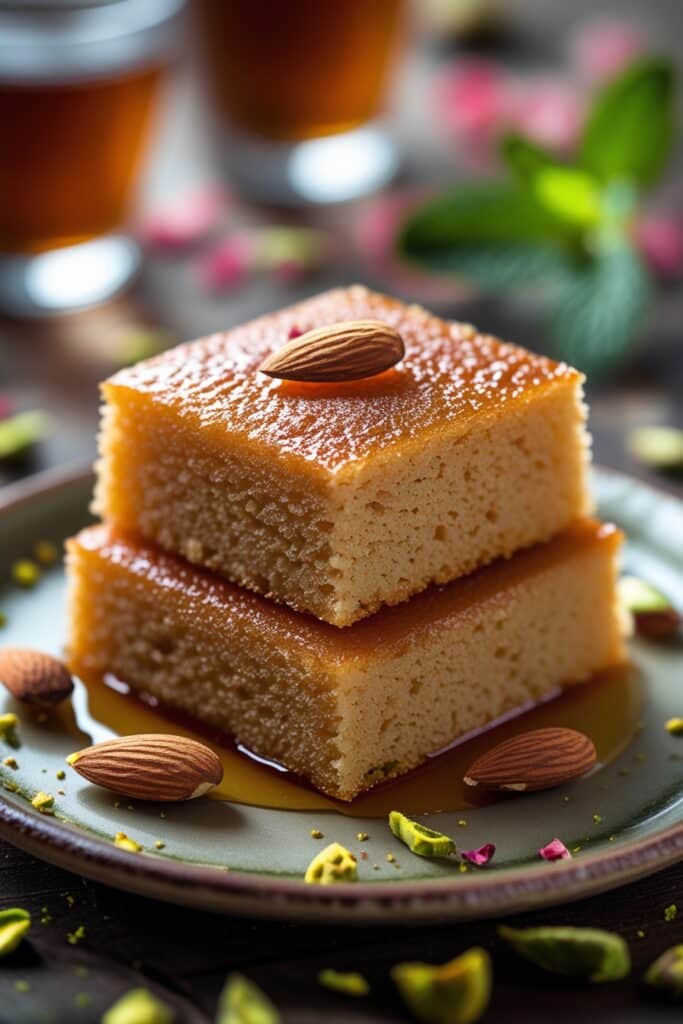
Maamoul: Date-Filled Cookies with History
Maamoul cookies are small, molded shortbread-style cookies filled with date paste, pistachios, or walnuts. These delightful bites are often dusted with powdered sugar and served during Eid, Christmas, or Easter in many Middle Eastern households.
What makes maamoul truly special is the traditional wooden mold used to shape them—each design representing a specific filling. The dough is usually made from a mix of flour and semolina, resulting in a texture that crumbles delicately in your mouth.
Making maamoul with your kids or family can be a beautiful memory-making activity. The process is therapeutic, and the result is deeply rewarding. It’s not unlike baking comforting treats for special occasions like our Easter dessert recipes.
Kunafa: Crunchy, Creamy, and Utterly Addictive
If there’s one Middle Eastern dessert that stops everyone in their tracks, it’s kunafa (or kanafeh). This indulgent pastry is made from shredded phyllo (kataifi), layered with gooey cheese or clotted cream (ashta), baked until golden, and soaked in fragrant syrup.
The contrast between crunchy top and creamy center makes every bite a celebration of texture. Regional variations include adding a layer of sweetened semolina pudding or tinting the pastry with saffron or turmeric for a golden glow.
Kunafa is often served hot and sliced like pie. If you’re someone who loves dramatic, decadent dishes, this is the Middle Eastern dessert for you.
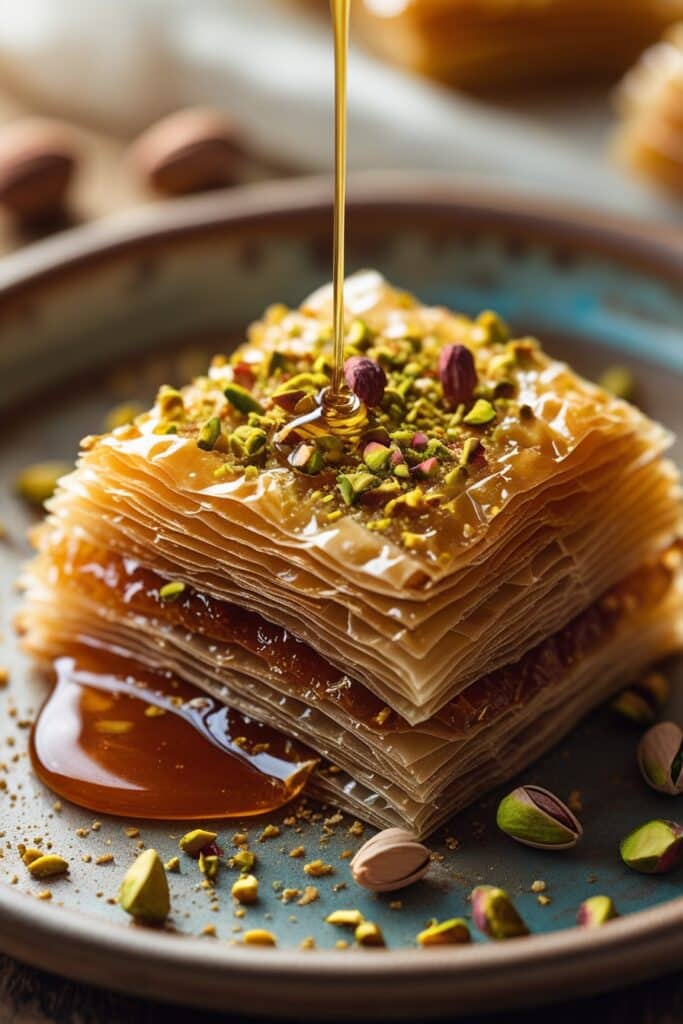
Rice Pudding and Muhallabia: Creamy Comfort in a Bowl
Rice pudding, known as roz bel laban in Egypt or sutlac in Turkey, is a gentle, creamy dessert often flavored with cinnamon, rose water, or mastic. It’s light, soothing, and a favorite for both children and adults.
Muhallabia is a similar milk-based pudding thickened with cornstarch, chilled, and garnished with pistachios or coconut. This is one of the easiest Middle Eastern desserts to prepare—ideal for beginners and incredibly customizable.
Both puddings are perfect alternatives to heavier sweets and are ideal for hot weather when you want something chilled but still satisfying. Like overnight oats, these desserts are smooth, comforting, and easy to digest.
The Role of Presentation and Gifting
In Middle Eastern culture, desserts are often presented with great care—stacked on platters, placed in tins, or served in delicate cups. Giving sweets is a gesture of love, hospitality, and respect. During Ramadan, it’s common for neighbors to exchange trays of basbousa, qatayef, or maamoul. At weddings and baby showers, decorative boxes filled with baklava or Turkish delight are gifted as tokens of joy.
Much like bringing a beautiful gluten-free dessert to a family dinner, Middle Eastern dessert gifting is as much about the gesture as it is about the treat.
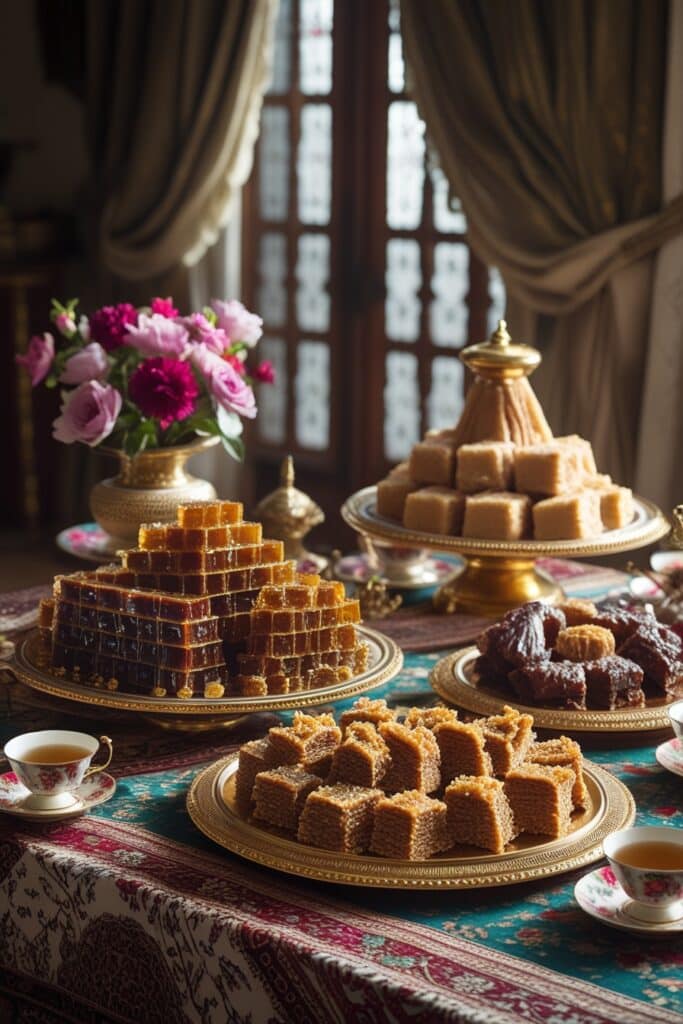
Modern Variations and Twists
Today’s foodies love experimenting with traditional flavors in modern formats:
- Baklava cheesecake
- Rose and cardamom ice cream
- Maamoul energy bites
- Basbousa muffins
These variations are perfect for introducing classic flavors to new generations. Imagine layering kunafa over your favorite no-bake cheesecake base or adding a tahini swirl to your banana bread—it’s about honoring tradition while making it yours.
Easy Middle Eastern Dessert Recipes for Beginners
You don’t need to be an expert pastry chef or have a professional kitchen to make Middle Eastern desserts at home. Most recipes are surprisingly simple and require only a few core ingredients you likely already have—like sugar, butter, semolina, and nuts. It’s the combinations, aromas, and preparation methods that make them feel so luxurious.
If you’re starting out, begin with:
Muhallabia: This creamy dessert comes together quickly on the stovetop and sets beautifully in the fridge, making it a perfect make-ahead treat.
Stuffed Dates: Just remove the pits, fill each date with your favorite filling—like almonds, soft cheese, or tahini—and finish with a topping of chopped pistachios for extra flavor and crunch.
Stuffed Dates: Simply pit and fill dates with almonds, cream cheese, or tahini, then sprinkle with crushed pistachios.
Think of these as the “overnight oats” of Middle Eastern sweets—simple, customizable, and endlessly comforting. You can even borrow tips from our Weight Watchers overnight oats recipe to create lighter versions.
Step-by-Step Tips to Get It Right
These traditional Middle Eastern sweets are surprisingly simple to make, despite appearing complex at first glance:
Measure with Care: Middle Eastern baking tends to be precise—especially with syrup ratios. Too much, and your dessert will turn soggy. Too little, and it may taste dry.
Use the Right Syrup Temperature: When soaking cakes or pastries like baklava, hot dessert + room temp syrup (or vice versa) ensures proper absorption.
Toast Your Nuts: Lightly toasting almonds or pistachios before using them enhances the flavor dramatically.
Don’t Skip the Resting Time: Whether it’s basbousa batter or maamoul dough, letting mixtures rest improves texture and binding.
If you’re used to making treats like carrot cake bars, you’ll find many similarities in the process—mixing dry and wet separately, using a simple syrup glaze, and baking until golden.
Pantry Staples to Keep on Hand
Craving Middle Eastern sweets on a whim? Here’s how to be ready anytime ? Stock these basics:
Ingredient Purpose
| Ingredient | Purpose |
|---|---|
| Semolina (fine/coarse) | Adds texture to cakes like basbousa |
| Rose water | Delicate floral essence for syrups/puddings |
| Orange blossom water | Sweet citrusy aroma for pastries |
| Pistachios | Topping and filling in cookies and cakes |
| Dates | Natural sweetener, especially in maamoul |
| Phyllo dough | Essential for baklava and kunafa |
| Ghee or Clarified Butter | Adds richness and authentic depth |
You’ll notice these ingredients appear repeatedly, whether you’re baking, boiling, or layering. Much like how we keep oats, nut butters, and honey ready for healthy breakfasts, these core items make Middle Eastern baking feel second nature.
Kitchen Tools That Make Things Easier
While you can absolutely make these desserts with just a mixing bowl and oven, a few extras can really help:
- Maamoul molds: Create traditional shapes for date-filled cookies.
- Pastry brush: For evenly buttering phyllo layers in baklava.
- Citrus zester: Perfect for adding orange or lemon zest to syrup.
- Nut grinder or food processor: Helps prepare fine nut fillings.
- Small saucepan: Ideal for simmering syrups and milk puddings.
If you’re just getting into international baking, don’t worry about buying everything at once. Start small—just like you would when trying a gluten-free recipe for the first time.
Flavor Swaps and Ingredient Substitutions
Can’t find orange blossom water or semolina at your local store? No problem. Here are easy substitutions:
- Semolina: Try cream of wheat or even fine cornmeal for a similar texture.
- Rose/Orange Blossom Water: Use a few drops of vanilla or almond extract (it won’t be traditional, but still tasty).
- Ghee: Melted unsalted butter is an acceptable swap.
- Pistachios: Use almonds or walnuts based on availability or preference.
- Phyllo dough: In a pinch, you can use puff pastry, though texture will differ.
These swaps help make the experience accessible and allow for creativity. For example, adding a hint of cinnamon or nutmeg can tie these flavors into Western-friendly desserts like a carrot cake.
Time-Saving Hacks for Busy Home Cooks
We’re all short on time, so here’s how to bring Middle Eastern flavors to your kitchen without stress:
We’re all short on time, so here’s how to bring Middle Eastern flavors to your kitchen without stress:
Use ready-made date paste for maamoul instead of blending your own.
Prepare larger batches of baklava or basbousa and freeze individual portions for quick treats later.
Cook your syrup in advance and store it in sealed jars in the fridge—it’ll stay fresh for up to two weeks.
Use muffin tins to shape mini kunafa portions, making them easy to bake, chill, and serve whenever needed.
It’s about balancing ease with flavor—just like how our turkey lunch meat guide simplifies weekly meal prep.
The Cultural Joy and Fusion of Middle Eastern Desserts
Why Middle Eastern Desserts Are More Than Just Sweets
In Middle Eastern households, dessert is more than an afterthought—it’s part of the tradition. Middle Eastern desserts are served to show hospitality, share love, and honor guests. Whether it’s a platter of baklava or freshly baked maamoul, offering something sweet is a cherished custom across the region.
These desserts often appear at weddings, religious holidays, and family gatherings. Sharing Middle Eastern desserts at the table creates a sense of togetherness, just as baking familiar treats like carrot cake bars brings comfort to many homes in the U.S.
Beautiful Ways to Present Middle Eastern Desserts
The presentation of Middle Eastern desserts is just as important as how they taste. Trays of syrup-soaked pastries, rose-scented puddings, and golden cookies are arranged with care and intention. Baklava is cut into diamonds or spirals, maamoul is shaped with carved molds, and puddings like muhallabia are garnished with crushed pistachios.
To serve Middle Eastern desserts like a pro, try these tips:
| Dessert | Presentation Idea |
|---|---|
| Baklava | Cut in geometric patterns, top with crushed nuts |
| Maamoul | Stack neatly and dust with powdered sugar |
| Basbousa | Bake in a tray, score diagonally, top with almonds |
| Muhallabia | Serve chilled in small glasses with rose petals |
| Kunafa | Slice warm, drizzle syrup tableside for effect |
Much like you’d present gluten-free dinner table treats with thought, Middle Eastern desserts deserve the same attention to detail.
Gifting with Sweets: A Timeless Tradition
In the Middle East, gifting sweets is a meaningful gesture. During Eid, Ramadan, and other holidays, friends and neighbors exchange boxes of homemade desserts. Tins filled with baklava or trays of basbousa become part of the celebration.
You can create your own gift set of Middle Eastern desserts at home:
- A few slices of baklava
- A couple of maamoul cookies with pistachio or walnut filling
- A jar of homemade sugar syrup with orange blossom water
- A small tag describing the history or flavor of each dessert
This makes a thoughtful gift, just like baking Easter treats for loved ones or packing up carrot cake mix bars for a neighbor.
Modern Twists on Middle Eastern Desserts
Today’s bakers and food lovers are getting creative, blending the flavors of Middle Eastern desserts with popular Western recipes. The result? A delicious fusion of old and new.
Here are a few ideas that bring tradition into the modern kitchen:
- Rose Pistachio Cheesecake: Creamy cheesecake infused with rose water and topped with crushed pistachios.
- Tahini Chocolate Cookies: Soft cookies with a nutty, Middle Eastern twist.
- Maamoul-Stuffed Brownies: Fudgy brownies with date or nut-filled maamoul centers.
- Baklava Ice Cream: Crispy pastry layers folded into vanilla or pistachio ice cream.
These updated versions make it easier to introduce Middle Eastern desserts to those unfamiliar with them. You can even sprinkle crushed maamoul over your overnight oats for a flavorful topping.
Where to Buy Authentic Middle Eastern Desserts
If you’re not ready to bake just yet, you can still enjoy Middle Eastern desserts by purchasing them from:
- Middle Eastern bakeries
- Mediterranean grocery stores
- Online specialty shops
- Local farmers’ markets with global food vendors
Trying a professional version of kunafa or basbousa is a great way to understand how these Middle Eastern desserts should look, taste, and feel. Once you’ve tasted the real deal, recreating them at home becomes much easier.
Middle Eastern Desserts Are a Connection to Culture
Whether you’re preparing dessert for a holiday, gifting it to a neighbor, or making it just because—Middle Eastern desserts bring warmth into any home. From the floral notes of rose water to the crunch of toasted pistachios, these sweets are made to delight.
By making Middle Eastern desserts in your own kitchen, you’re not just exploring new flavors—you’re connecting to centuries of culinary tradition. Even simple steps, like layering kunafa in muffin tins or baking a tray of basbousa on a Sunday, become moments of cultural appreciation.
Pairing Middle Eastern desserts with your usual weekly prep meals or cozy family dishes can turn any meal into something special. These recipes aren’t just dessert—they’re a celebration of joy and history on your plate.
What are traditional Middle Eastern desserts made of?
Middle Eastern desserts are often made using semolina, nuts like pistachios and walnuts, dates, ghee or butter, and flavored syrups. Signature aromas come from rose water and orange blossom water, giving these sweets their unique scent and taste.
What is the most famous dessert in the Middle East?
Baklava is arguably the most recognized Middle Eastern dessert. Made from layers of phyllo dough, chopped nuts, and sweet syrup, it’s served at weddings, holidays, and special events across many countries.
Are Middle Eastern desserts healthy?
Many Middle Eastern desserts include nutrient-rich ingredients like dates, tahini, and nuts. While syrup and butter are often used, there are lighter variations using natural sweeteners and minimal fat for more health-conscious options.
How are Middle Eastern desserts different from Western sweets?
Unlike many Western desserts that use chocolate, heavy creams, or frostings, Middle Eastern desserts focus on syrup-soaked textures, floral essences, and natural ingredients like semolina, coconut, and nuts. They’re generally more aromatic and less sugary.
Conclusion: A Sweet Journey Worth Taking
Middle Eastern desserts offer more than indulgence—they’re stories told through taste. From the syrupy crunch of baklava to the creamy calm of muhallabia, each dish carries heritage, hospitality, and heart. Whether you’re experimenting with flavors or embracing long-held traditions, these sweets invite you into a world of warmth and wonder.
You don’t need a special occasion to enjoy Middle Eastern desserts. Try them alongside your everyday meals or surprise your guests with a rose-scented pudding after dinner. From your kitchen to your table, these desserts are an invitation to experience joy—bite by bite.

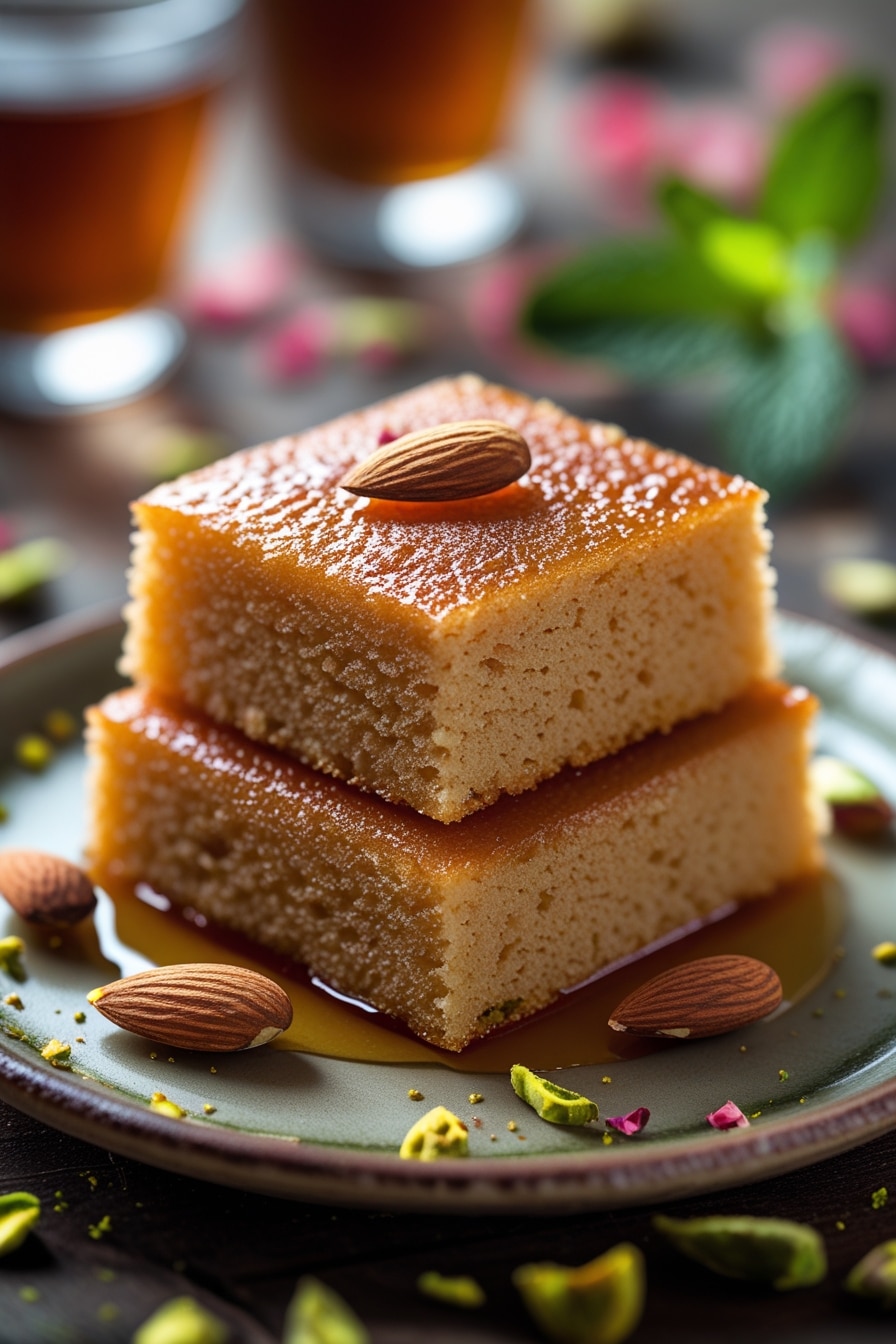
1 thought on “Middle Eastern Desserts”